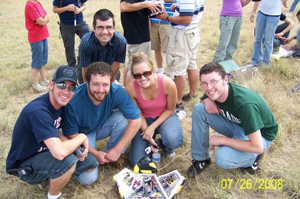CSU Students Put Their Heads Together to Design a Low-cost Weather Station for Mars
 |
|
The DemoSat team with their project, "HabiSAT"
|
The National Aeronautics and Space Administration (NASA) is helping build the nation's future workforce through the National Space Grant College and Fellowship Project. Under this program, a network of university-based Space Grant consortia offers undergraduate research opportunities in all 50 states, the District of Columbia, and Puerto Rico.
As participants in the Colorado Space Grant Consortium's DemoSat Project, a group of undergraduate students at Colorado State had the opportunity to get hands-on experience in aerospace and technology development. As DemoSat summer interns, the students choose their projects from a list of challenges provided by NASA, and can present their work to engineers at NASA's Jet Propulsion Laboratory at the end of the summer.
Mechanical engineering students Zachary Wiggins, John Lucas and Christopher Reed, and engineering science major Christina Watanuki made up CSU's DemoSat research team this year. Associate Professor Azer Yalin is the faculty adviser for DemoSat, as well as for CSU’s student chapter of the American Institute of Aeronautics and Astronautics.
The DemoSat internship gives the students a lot of freedom to choose a project that they think will improve space exploration. This summer, the student team designed HabiSAT with the objective to provide a low-cost weather station to function on the surface of Mars. The station’s capabilities include measuring temperature, humidity, atmospheric pressure, and seismic activity, as well as taking photographs during flight and at the landing site. "The potential benefit to NASA and the scientific community is that it could be used to map a large area of Martian environments," says Watanuki.
After designing and constructing it from scratch, the students launched HabiSAT on a high altitude weather balloon on July 26th, 2008. The weather station reached an altitude of 97,774 feet; that's almost the edge of space, which is 100,000 feet.
"My time in CSU’s Engineering school has been an incredible experience," says Reed. "To date, DemoSat has been my most challenging and motivating experience. We were able to design something completely unique that could potentially find use in modern space flight."